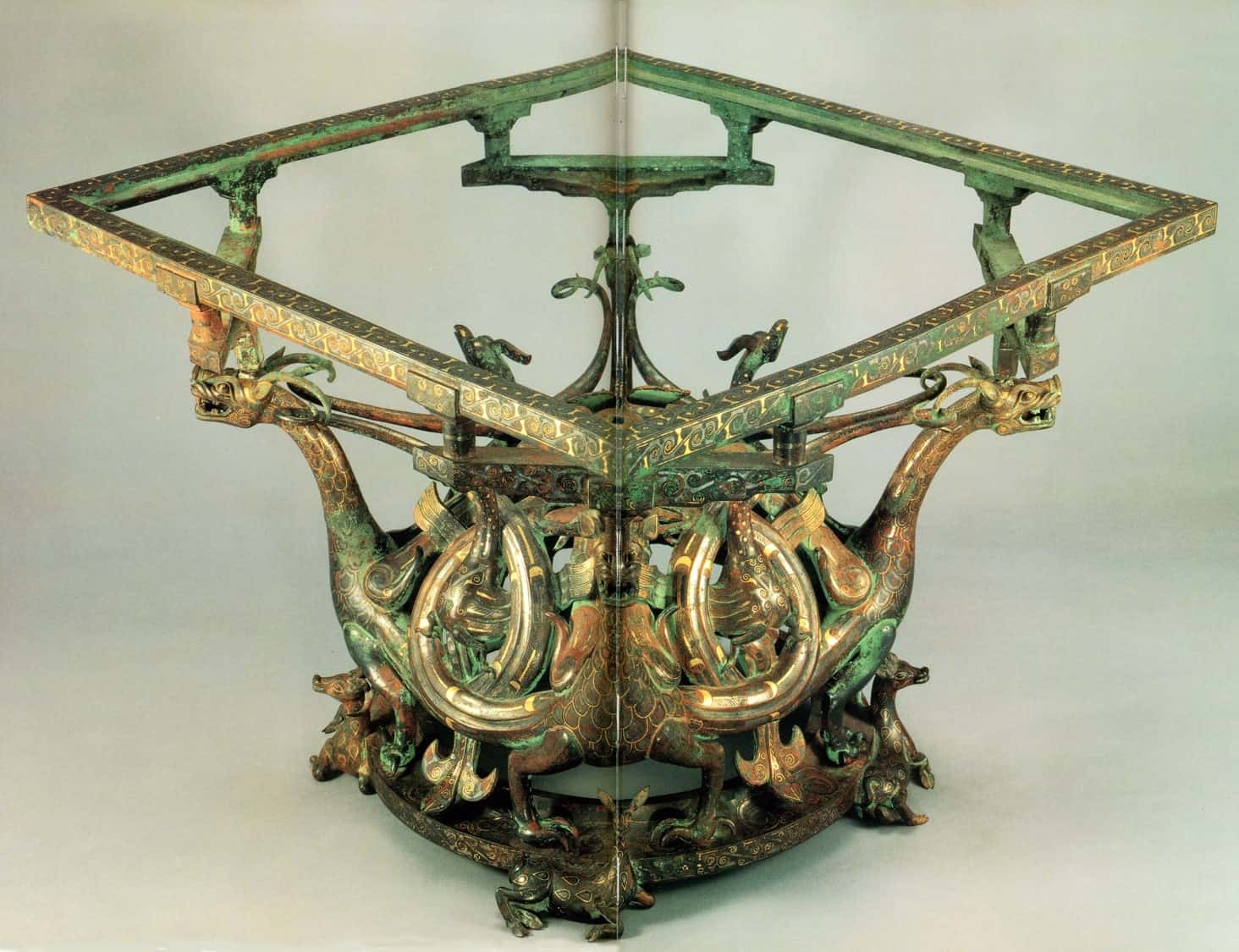Mythical Guardians of the Zhongshan King’s Table: Decoding the Artistic Genius of the Warring States Period

The ancient world is a tapestry of captivating stories, each thread woven with the remarkable feats of our ancestors. Among the countless treasures that continue to captivate scholars and enthusiasts alike, the discovery of a meticulously crafted bronze table frame in the tomb of King Cuo of Zhongshan stands as a testament to the artistic and technological prowess of the Warring States period in China.
The Magnificent Bronze Table Frame
In 1977, an extraordinary archaeological find was made in the Hebei province of China – the tomb of King Cuo of Zhongshan, who reigned from 327 to 309 BC. Within the confines of this ancient resting place, researchers uncovered a breathtaking bronze table frame, adorned with intricately inlaid gold and silver motifs.
The table frame is a true masterpiece of its time, measuring an impressive 76.5 cm in length and 45.5 cm in width. Its surface is adorned with a captivating design, featuring four dragons and four phoenixes, symbols of power and prosperity in Chinese mythology. The meticulous craftsmanship and the harmonious integration of these mythical creatures create a visually stunning piece that seamlessly blends form and function.
Mastery of Metalworking Techniques
The technical prowess displayed in the creation of this bronze table frame is nothing short of remarkable. The inlaying of gold and silver into the bronze surface required a deep understanding of metallurgy and a keen eye for detail. The precision with which the figures were rendered, the seamless integration of the various elements, and the overall structural integrity of the piece all point to the exceptional skills of the artisans who brought this masterpiece to life.

Insights into the Warring States Period
The discovery of the Zhongshan King’s bronze table frame offers valuable insights into the cultural and political landscape of the Warring States period in China. This era, marked by constant power struggles and territorial disputes, was also a time of remarkable cultural and artistic flourishing. The table frame, with its regal and symbolic motifs, serves as a tangible representation of the power and wealth of the Zhongshan Kingdom during this tumultuous period of Chinese history.
Preservation and Display
The Zhongshan King’s bronze table frame, a true marvel of its time, is now housed at the Hebei Museum in China, where it continues to captivate and inspire visitors from around the world. The exceptional state of preservation of this artifact is a testament to the care and dedication of the researchers and conservators who have worked tirelessly to ensure its long-term survival.
Conclusion
The discovery of the Zhongshan King’s bronze table frame is a testament to the enduring legacy of the ancient world. This exquisite masterpiece, crafted with unparalleled skill and artistry, stands as a testament to the ingenuity and creativity of our ancestors. As we continue to uncover and study these remarkable artifacts, we gain a deeper understanding of the rich cultural tapestry that has shaped our shared history. The Zhongshan King’s bronze table frame is a true treasure, a window into the past that ignites our imaginations and inspires us to explore the wonders that still await us in the enduring legacy of the ancient world.
Video
News
The Hanging Temple: China’s 1,500-Year-Old Cliffside Marvel of Faith and Engineering
The Hanging Temple: China’s 1,500-Year-Old Cliffside Marvel of Faith and Engineering Perched precariously on the cliffs of Mount Heng in Shanxi Province, China, the Hanging Temple, also known as Xuankong Temple, Hengshan Hanging Temple, or Hanging Monastery, is an architectural…
The Willendorf Venus: A 30,000-Year-Old Masterpiece Reveals Astonishing Secrets
The Willendorf Venus: A 30,000-Year-Old Masterpiece Reveals Astonishing Secrets The “Willendorf Venus” stands as one of the most revered archaeological treasures from the Upper Paleolithic era. Discovered in 1908 by scientist Johann Veran near Willendorf, Austria, this small yet profound…
Unveiling the Maya: Hallucinogens and Rituals Beneath the Yucatán Ball Courts
Unveiling the Maya: Hallucinogens and Rituals Beneath the Yucatán Ball Courts New archaeological research has uncovered intriguing insights into the ritual practices of the ancient Maya civilization. The focus of this study is a ceremonial offering found beneath the sediment…
Uncovering the Oldest Agricultural Machine: The Threshing Sledge’s Neolithic Origins
Uncovering the Oldest Agricultural Machine: The Threshing Sledge’s Neolithic Origins The history of agricultural innovation is a fascinating journey that spans thousands of years, and one of the earliest known agricultural machines is the threshing sledge. Recently, a groundbreaking study…
Nara’s Ancient Sword: A 1,600-Year-Old Protector Against Evil Spirits
Nara’s Ancient Sword: A 1,600-Year-Old Protector Against Evil Spirits In a remarkable discovery that has captured the attention of archaeologists and historians alike, a 7.5-foot-long iron sword was unearthed from a 1,600-year-old burial mound in Nara, Japan. This oversized weapon,…
The Inflatable Plane, Dropped Behind the Lines for Downed Pilots
Experimental The Inflatable Plane, Dropped Behind the Lines for Downed Pilots The Inflatoplane from Goodyear was an unconventional aircraft developed by the Goodyear Aircraft Company, a branch of the renowned Goodyear Tire and Rubber Company, also famed for the Goodyear…
End of content
No more pages to load












